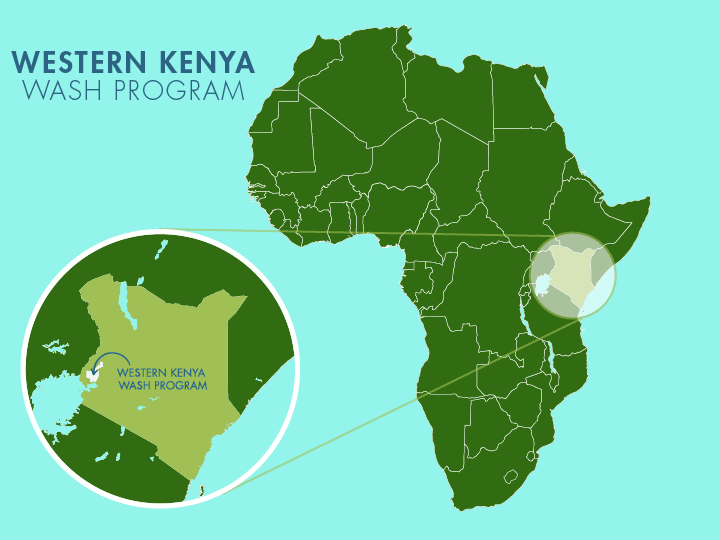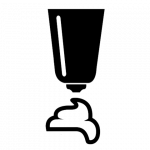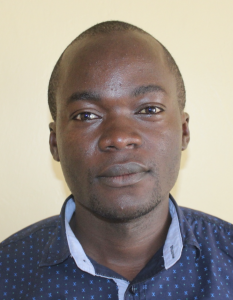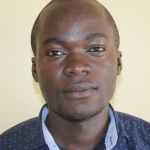In the green but uneven terrain of the Shipala Community in Kakamega County, Kenya, 182 people rely on the Kuka Mufwoyongo Spring for their daily water needs. It’s the only one that doesn’t run dry during the year, and it serves a large population. Yet, what was once a reliable source of clean water has now become overcrowded, unsafe, and broken down. Their only other option is collecting surface water throughout the community.

Collecting surface water.
The spring’s collection area is slippery and worn out, its pipe rusted and corroded. The spring box is left open, allowing rainwater and waste materials to contaminate it, especially during the rainy season. Bushes grow thick around it — though residents try to clear them — and the ground is uneven and hazardous. It’s a place where children risk slipping on sharp rocks, where mothers argue in long queues, and where everyone must wait their turn for water that isn’t always safe to drink.

Long lines at the spring.
Among those who face these challenges every day is 12-year-old Mercy, a bright and determined girl. Her daily walk for water has shaped much of her young life.
Mercy spends around fifteen minutes each day fetching water, but the task feels much longer. The spring is always crowded, and the wait is exhausting.
“Overcrowding and long queues make collecting water from this particular water point very difficult and stressful,” she says, reflecting the frustration that has become a part of her routine.

Mercy.
Every trip brings its own obstacles.
“The safety at the current waterpoint is not guaranteed, as people, most of [the] time, are quarreling, especially mothers exchanging words with others. This is due to long queues and overcrowding. The surface at the waterpoint is also very slippery and has sharp rocks, which are dangerous," said Mercy.
For a child like Mercy, these moments can be intimidating. Even as she waits her turn, she faces disrespect from both adults and other children.
“Several times, elderly people have been unkind to me. I can't fetch water fast when they are around; they believe the elders ought to be given first priority before the children. This makes the whole activity of water collection difficult and stressful," she lamented.

“Yes, I normally get pushed by the stronger children, and I'm forced to wait for a very long time before I get the chance to fetch water. This situation has occurred to me several [times] with [the] majority of people disrespecting me because of my age and my short stature," she continued.
What should be a simple daily task has become a long, weary battle — one that takes time, energy, and courage.
Like many children in Shipala, Mercy’s responsibilities at home are heavy. After fetching water, she helps her parents with chores and tries to keep up with her schoolwork. But the long hours at the spring make it hard to balance everything.
“As a child, I would utilize my time in helping my parents with house chores, including collecting enough water, cleaning the compounds, and also feeding the animals. The remaining time I will spend it doing school assignments and studying challenging subjects in school,” she explains — imagining how much more she could accomplish if she didn’t spend so much time queuing for water.

“Collecting water in the spring reduces my study time, I cannot do homework on time, hence being punished at school. It makes me lag behind in some topics for not attending morning preps. This makes me not perform well in some subjects like mathematics," Mercy shared.
The hours lost at the spring are hours lost for her education — and for her dreams. Despite the hardships, Mercy carries a clear and powerful vision for her future.
“I have a very big ambition of working hard in school so that I can become a doctor, so that I can help my family and my community," declared Mercy.
Her dream is born out of the same struggle that has shaped her life. The challenges of water scarcity and unsafe access have taught her resilience and compassion — qualities that fuel her desire to one day serve others. Yet, for now, the broken spring remains a barrier.
“I often feel hesitant to go there because I know for sure it is a long struggle in the queue. The water collection point makes me irritated because it is slippery and has sharp rocks," Mercy said.

It’s a burden no child should have to bear — a daily reminder of the urgent need for a safe, protected, and reliable water source.
When asked what a new water point would mean for her community, Mercy’s answer is simple yet profound: “The new water point will ensure that people are not queuing or overcrowding at the water source for a very long time, hence bringing peace and harmony amongst us.”
For Mercy, clean water means more than health; it means peace. It means time to study and to dream. It means respect and safety for everyone, regardless of age. It means freedom from the daily anxiety of quarrels and long queues.
Clean water will bring hope back to Shipala and give its children, like Mercy, the chance to finally thrive.
Steps Toward a Solution
Our technical experts worked with the local community to identify the most effective solution to their water crisis. They decided to safeguard the existing flowing spring.
Spring Protection
Springs are natural water sources that originate from deep underground. As water travels through various layers of the earth, it undergoes a natural filtration process, making it cleaner and safer to drink. To protect these spring sources from contamination, we construct a waterproof cement structure around layers of clay, stone, and soil. This design channels the spring water through a discharge pipe, facilitating easier, faster, and cleaner water collection.
Chlorine Dispenser
As an extra measure towards water quality safety, uniquely engineered chlorine dispensers are installed at all of our spring protection projects so community members can treat their water with pre-measured doses of chlorine. The chlorine treats any possible contamination and stays active for two to three days, ensuring water stays safe to use even when stored at home. Chlorine delivery and maintenance of the dispensers are part of our ongoing community support.
Community Education & Ownership
Hygiene and sanitation training are integral to our water projects. Training is tailored to each community's specific needs and includes key topics such as proper water handling, improved hygiene practices, disease transmission prevention, and care of the new water point. Safe water and improved hygiene habits foster a healthier future for everyone in the community. Encouraged and supported by the guidance of our team, a water user committee representative of the community's diverse members assumes responsibility for maintaining the water point, often gathering fees to ensure its upkeep.

 Protected Spring
Protected Spring
 Rehabilitation Project
Rehabilitation Project


















